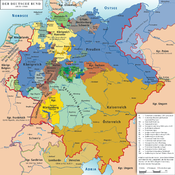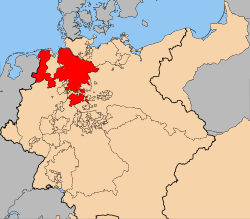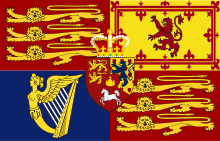- Kingdom of Hanover
-
Kingdom of Hanover
Königreich HannoverState of the German Confederation,
until 1837 in personal union with the United Kingdom← 
1814–1866  →
→

Flag Coat of arms The Kingdom of Hanover within the German Confederation Capital Hanover Government Constitutional monarchy King - 1814–20 George III - 1820–30 George IV - 1830–37 William - 1837–51 Ernest Augustus - 1851–66 George V History - Battle of Nations October 19, 1813 - Congress of Vienna October 12, 1814 - Austro-Prussian War September 20, 1866 Currency Hanoverian Vereinsthaler Today part of  Germany
GermanyThe Kingdom of Hanover (German: Königreich Hannover) was established in October 1814 by the Congress of Vienna, with the restoration of George III to his Hanoverian territories after the Napoleonic era. It succeeded the former Electorate of Brunswick-Lüneburg (known informally as the Electorate of Hanover), and joined with 38 other sovereign states in the German Confederation. The Kingdom was ruled by the House of Hanover, in personal union with the United Kingdom of Great Britain and Ireland until 1837, before being conquered by Prussia in 1866. Briefly revived as the State of Hanover in 1946, the state was subsequently merged with some smaller states to form the current state of Lower Saxony.
Contents
History
Main article: History of HanoverThe territory of Hanover had earlier been a Principality within the Holy Roman Empire; before being elevated into an electorate in 1708. Hanover was formed by the union of several dynastic divisions of the Duchy of Brunswick-Lüneburg, with the sole exception of the principality of Brunswick-Wolfenbüttel.
Between 1714 and 1837 it was joined in a personal union, first with the Kingdom of Great Britain and the Kingdom of Ireland, and then, from 1801, with the United Kingdom of Great Britain and Ireland. In 1803 the electorate was occupied by French and Prussian troops, and following the Treaties of Tilsit in 1807, its territories together with territories ceded from Prussia was created into the Kingdom of Westphalia ruled by Napoleon's brother Jérôme Bonaparte. French control lasted until October 1813 when the territory was overrun by Russian cossack troops, and the Battle of the Nations at Leipzig later the same month spelled the definitive end to the Napoleonic client state as well as the entire Confederation of the Rhine, after which the House of Hanover was restored as rulers.
The Prince-Electors, formerly vassals within the Holy Roman Empire, were elevated to monarchs of an independent kingdom at the Congress of Vienna in 1814. This was conducted under the supervision and advice of Baron Münster, head of the German Chancery in London.
During the British Regency and the reigns of the kings George IV and later William, their younger brother Prince Adolphus, Duke of Cambridge officiated as Viceroy of Hanover (1816–37), representing the King usually living in England. When Adolphus's niece, Queen Victoria, daughter of his late elder brother Prince Edward, Duke of Kent and Strathearn, succeeded to the British Throne on 20 June 1837, the 123-year personal union of the crowns of Great Britain (or the United Kingdom of Great Britain and Ireland from 1801, respectively) and Hanover (or the Electorate of Brunswick-Lüneburg before 1814, respectively) ended. Salic law, which requires succession by exclusively male inheritance, operated in Hanover but not in Great Britain; Victoria could not become Queen of Hanover. Adolphus's other elder brother, therefore, became King as Ernest Augustus I of Hanover and Adolphus returned to Britain.
During the Austro-Prussian War (1866), Hanover attempted to maintain a neutral position, along with some other member states of the German Confederation. Hanover's vote in favor of the mobilisation of Confederation troops against Prussia on 14 June 1866 prompted Prussia to declare war. The outcome of the war led to the dissolution of Hanover as an independent kingdom and it was annexed by Prussia, where it became the Province of Hanover. The German-Hanoverian Party, which at times supported secession from the Reich, demanded a separate status for the province in the Reichstag. The party existed up until it was banned by the Nazi government. After George V fled Hanover, he raised forces loyal to him in the Netherlands called the Guelphic Legion. They were eventually disbanded in 1870.
Revival and modern history
In 1946, Hanover was revived as a state, named the State of Hanover. The state saw itself in the tradition of the kingdom. Its Prime Minister, Hinrich Wilhelm Kopf, played a central role when the state of Lower Saxony was founded just a few months later by merging Hanover with several smaller states. The state of Lower Saxony continues to use the Hanover coat of arms.
Reorganisation of religious bodies in Hanover
The Lutheran church was the state church of the Kingdom of Hanover with the King being summus episcopus (Supreme Governor of the Lutheran Church). Regional consistories supervised church and clergy. These were in Aurich, a simultaneously Lutheran and Calvinist consistory dominated by Lutherans (for East Frisia) and the Lutheran consistories in Hanover (for the former Electorate of Brunswick-Lüneburg proper), in Ilfeld (for the County of Hohenstein, a Hanoverian exclave in the Eastern Harz mountains), in Osnabrück (for the former Prince-Bishopric of Osnabrück), in Otterndorf (existed 1535–1885 for the Land of Hadeln) as well as in Stade (existed 1650–1903, until 1885 for the former Bremen-Verden proper without Hadeln, then including the complete Stade region). A general superintendent chaired each consistory.
In 1848, the Lutheran parishes were democratized by the introduction of presbyteries (German: Kirchenvorstände, singular Kirchenvorstand; literally: church boards), elected by all major male parishioners and chairing each congregation in co-operation with the pastor, being before the sole chairman. This introduction of presbyteries was somewhat revolutionary in the rather hierarchically structured Lutheran church. In 1864, Carl Lichtenberg, Hanoverian minister of education, cultural and religious affairs (1862–65), persuaded the Ständeversammlung (lit. Estates Assembly, the Hanoverian parliament) to pass a new law as to the constitution of the Lutheran church. The constitution provided a state synod (parishioners' parliament, German: Landessynode). But its first session only materialised in 1869 when, after the 1866 Prussian annexation of the Kingdom of Hanover, the Hanoverian Lutherans desired a representative body separate from Prussian rule, though it was restricted to Lutheran matters only.
After the Prussian conquest in 1866, on 19 September 1866, the day before the official Prussian annexation took place and with the last summus episcopus, King George V of Hanover, in exile, the Kingdom's six consistories joined to form today's still-existing church body (Lutheran State Church of Hanover). An all-Hanoverian consistory, the Landeskonsistorium (state consistory), was formed with representatives from the regional consistories.
While the Calvinist congregations in formerly-Prussian East Frisia had a common roof organization with the Lutherans there ("Coetus") and the Reformed Church in the former County of Bentheim, then being the state church, had fully established church bodies for Bentheim only (German: Königlich-Großbrittanisch-Hannoverscher Ober-Kirchenrath, English: Royal British-Hanoverian Supreme Church Council), the Calvinist congregations elsewhere in Hanover were in a somewhat sorry state. Though some Calvinist congregations of Huguenot origin were organized in the Lower Saxon Confederation (German: Niedersächsische Konföderation). The Lutheran church being the state church of Hanover also supervised the Calvinist diaspora parishes outside East Frisia and Bentheim. In 1848 the new Hanoverian law also provided for presbyteries in these Calvinist parishes, which exactly fit the presbyterian structure of Calvinism.[1]
Catholics formed an overall minority in Hanover, but regionally majorities in the former prince-bishoprics. By the annexations in 1803 and 1814 Hanover had become a state of three Christian denominations. In 1824 Hanover and the Holy See thus agreed to integrate diaspora parishes which were located in prevailingly Protestant areas, until then supervised by the Roman Catholic Vicariate Apostolic of the Nordic Missions, into the existing dioceses of the former prince-bishoprics, whose diocesan territories were thus extended into the diaspora areas.
Jews lived all over Hanover in diaspora. Until 1806, they were not allowed to reside in some areas. By the Westphalian and French annexations in 1807 and 1810 all male inhabitants in later restituted Hanover became Westphalian or French citizens of equal rights, though on 17 March 1808 Napoléon Bonaparte restricted the rights of Jews in the French-annexed territory by his so-called décret infâme. The Jewish congregations became subject to the French or Westphalian Jewish Consistory, respectively. When Hanover resumed independence and sovereignty in 1813 its government deprived the Jews their legal equality. Arguing it was the French or Westphalian state and not Hanover, which had emancipated the Jews, the government took the decisions of the German Confederation on the rights of the Jews, in Johann Smidt's manipulated formulation, as the legal grounds.[2]
In 1842, Hanover finally granted equal rights to Jews and promoted to build up Jewish congregations, where this did not already happen earlier, and a superstructure of four regional land-rabbinates. In many diaspora areas Jews regarded this a progress and a burden alike, because of the implied financial burden for rabbins and religion teacher, synagogues or schools. The local authorities now requested that the Jewish congregations establish synagogues and Jewish education for the pupils. The land-rabbins, chairing the land-rabbinates, simultaneously fulfilled religious and state functions, like supervising Jewish elementary schools and the teaching of Jewish religion in all schools. The Kingdom of Hanover was thus one of the few states within the German Confederation, where rabbins held a similar semi-state authoritative position as to Jews as did, e.g., Lutheran clergy towards Lutherans.[3]
Kings of Hanover
Main article: House of HanoverIn 1813, George III was restored to his Hanoverian territories, and in October 1814 they were constituted as the independent Kingdom of Hanover at the Congress of Vienna. The personal union with the United Kingdom ended in 1837 on the accession of Queen Victoria because the succession laws in Hanover, based on Salic law, prevented a female inheriting the title if there was any surviving male heir (in the United Kingdom, a male takes precedence only over his own sisters). In the Austro-Prussian War of 1866, Hanover was annexed by Prussia and became the latter's Province of Hanover.
Kings of Hanover Image Name Date Notes 
George III 1814–20 George III was mentally unfit during these years, and power was exercised by George, Prince of Wales (the future George IV) according to the British Regency. In Hanover, Prince Adolphus, Duke of Cambridge officiated as Viceroy from 1816. 
George IV 1820–30 Son of predecessor. Regent 1811–1820, represented in Hanover by Viceroy Adolphus. William 1830–37 Brother of predecessor. Last monarch to rule both Hanover and the United Kingdom, represented in Hanover by Viceroy Adolphus. 
Ernest Augustus 1837–51 Brother of predecessor. His accession separated the crowns of Hanover and the United Kingdom, as the latter passed to Queen Victoria. 
George V 1851–66 Son of predecessor. Lost his territories to Prussia in the Austro-Prussian War. Territory and administrative subdivisions
The Congress of Vienna instituted a territorial exchange between Hanover and the Kingdom of Prussia, in which Hanover increased its area substantially, gaining the Bishopric of Hildesheim, East Frisia, the Lower County of Lingen and the northern part of the Prince-Bishopric of Münster. It gained territories, partially ruled earlier in personal union, such as the Duchies of Bremen-Verden and partially ruled by others, to whit the County of Bentheim. It lost those parts of Saxe-Lauenburg to the northeast of the Elbe, which was assigned in personal union to Denmark, except the Amt Neuhaus. Further small exclaves in the east were lost.
Hanover thus comprised a number of territories, which had been Imperial Estates within the Holy Roman Empire. Their respective governments, now called provincial governments, were organised according to partially very old traditions, including different levels of estate participation in rule. In 1823 the kingdom was reorganised into high-bailiwicks (German: Landdrosteien, singular: Landdrostei), each led by a high-bailiff (German: Landdrost) according to unitary standards, thus doing away with the inherited provincial peculiarities.
The high-bailiwicks were subdivided into bailiwicks (German: Ämter, singular Amt), presided by a bailiff (Amtmann, plural Amtleute).[4] The high-bailiwicks, named after their capitals, were the following:
- Aurich, comprising former East Frisia
- Hanover, comprising about the former Principality of Calenberg in the Duchy of Brunswick-Lüneburg
- Hildesheim, comprising the former Brunswick-Lüneburg Principality of Grubenhagen and the former Prince-Bishopric of Hildesheim
- Lüneburg, comprising the former Brunswick-Lüneburg Principality of Lüneburg and the remainder of Saxe-Lauenburg areas
- Osnabrück, comprising the former County of Bentheim, the former Lower County of Lingen, and the former Prince-Bishopric of Osnabrück
- Stade, comprising the former Duchies of Bremen-Verden
The Hanoverian subdivisions into high-bailiwicks and bailiwicks remained unchanged until 1 April 1885, when they were replaced by Prussian-style provinces (Regierungsbezirke) and districts (Kreise).
Coat of arms
After the personal union with Britain ended in 1837, Hanover kept the British Royal Arms and Standards, only introducing a new Crown (after the British model).
See also
- King's German Legion
- Guelphic Legion
- House of Hanover
- Kleindeutsche Lösung
- State of Hanover
Notes
- ^ But only in 1882 — long after the Prussian annexation of Hanover — the inappropriate supervision by Lutheran consistorials ended, when the Evangelical Reformed Church of the Province of Hanover emerged, comprising all the Calvinist congregations in the prevailingly Lutheran Province of Hanover. The simultaneously Lutheran and Calvinist consistory in Aurich was made the consistory of that church body, becoming an exclusively Calvinist body only in 1922, following the constitutional reorganization of the church bodies after the Weimar Constitution had decreed the separation of church and state in 1919.
- ^ In the final revision of the decisions of the Congress of Vienna on the rights of the Jews, Smidt — unauthorized and unconsented by the other parties — had changed the text from "The confessors of Jewish faith are preserved the rights already conceded to them in the confederal states", by replacing a single word, which ensued serious consequences, into: "The confessors of Jewish faith are preserved the rights already conceded to them by the confederal states." cf. Heinrich Graetz, Geschichte der Juden von den ältesten Zeiten bis auf die Gegenwart: 11 vols., Leipzig: Leiner, 1900, vol. 11: 'Geschichte der Juden vom Beginn der Mendelssohnschen Zeit (1750) bis in die neueste Zeit (1848)', p. 317. Emphasis not in the original. Reprint of the edition last time revised by the author himself: Berlin: arani, 1998, ISBN 3-7605-8673-2. In the German original: "Es werden den Bekennern des jüdischen Glaubens die denselben in [von, respectively] den einzelnen Bundesstaaten bereits eingeräumten Rechte erhalten."
- ^ After the Prussian annexation the constitution of Hanover's four land-rabbinates came under threat to be abolished, because in Prussia proper the government hindered as much as possible the establishment of nationwide Jewish organisations, let alone such which it would grant official recognition. In the end, Prussia respected the existing Hanoverian land-rabbinate constitution, which continued to exist — modified according to the separation of state and religion in 1919 by the Weimar constitution — until the Nazi Reich's government de facto abolished the constitution in 1938.
- ^ This translation follows Jakob Heinrich Kaltschmidt, Neues vollständiges Wörterbuch der englischen und deutschen Sprache nebst einem kurzen Abrisse der englischen und der deutschen Sprachlehre (English: A new and complete Dictionary of the English and German Languages with two Sketches of Grammar, 6th, rev. and enriched ed., Leipsic: Otto Holtze, 1990, p. 283. No ISBN
 States of the German Confederation (1815–66)
States of the German Confederation (1815–66)Empires 
Kingdoms Electorates Grand Duchies Duchies Anhalt (Bernburg2 · Dessau2 · Köthen3) · Brunswick · Holstein · Limburg4 · Nassau · Saxe-Lauenburg · Saxony (Altenburg5 · Coburg-Saalfeld6 · Coburg-Gotha5 · Gotha-Altenburg6 · Hildburghausen6 · Meiningen)Principalities Hesse-Homburg · Hohenzollern (Hechingen7 · Sigmaringen7) · Liechtenstein · Lippe · Reuss (Elder · Junior) · Schaumburg-Lippe · Schwarzburg (Rudolstadt · Sondershausen) · Waldeck and PyrmontCity-states Other territories
outside of the
confederacyColonial possessions · Personal unions of Habsburg (Bukovina · Croatia · Galicia and Lodomeria · Hungary · Lombardy–Venetia · Serbian Voivodeship and Banat8 · Slavonia9 · Transylvania) · Personal union of Hanover (Great Britain and Ireland10) · Personal unions of Hohenzollern (East Prussia11 · Neuchâtel12 · Posen, Gr. Duchy13 · Posen, Prov.14 · Prussia, Prov.15 · West Prussia11) · Occupied: Schleswig161 w/o areas listed under other territories. 2 Merged with Anhalt from 1863. 3 until 1847. 4 from 1839. 5 from 1826. 6 until 1826. 7 until 1850. 8 1849–60. 9 as of 1849. 10 until 1837. 11 until 1829. 12 until 1848/57. 13 until 1848. 14 as of 1848. 15 as of 1829. 16 as of 1864.Categories:- Former monarchies of Europe
- Former countries in Europe
- Former state unions
- States and territories established in 1814
- States and territories disestablished in 1866
- Hanover
- Duchy of Brunswick-Lüneburg
- Kingdom of Hanover
Wikimedia Foundation. 2010.



